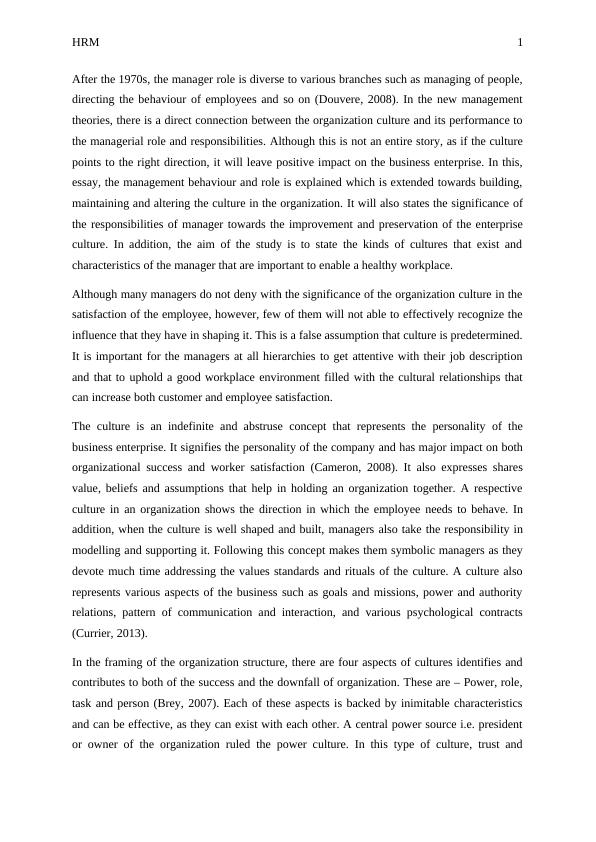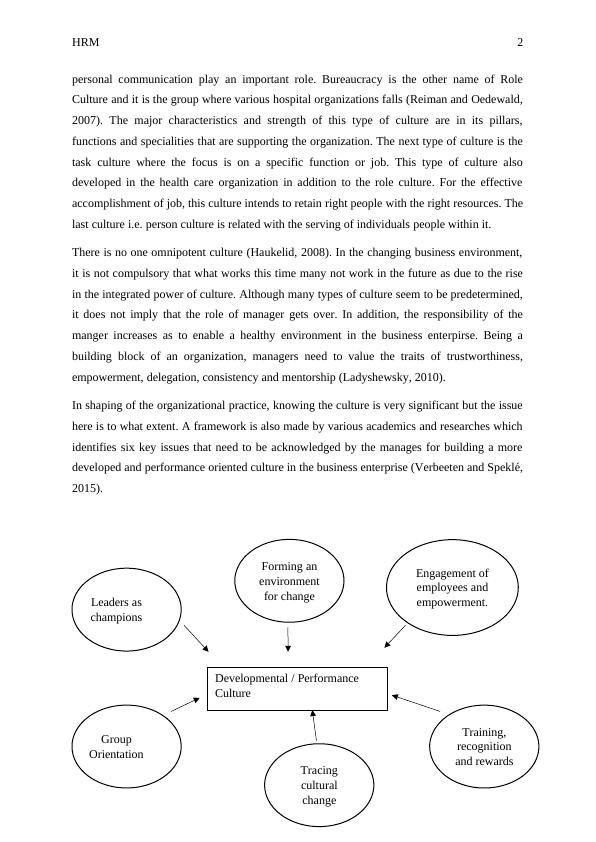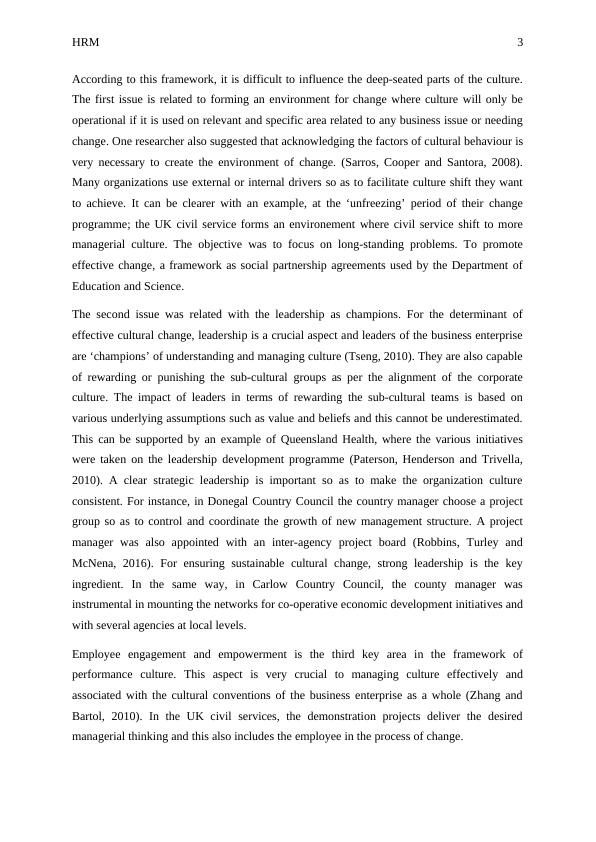Ask a question from expert
LM7505 Managing Human Resources
17 Pages6254 Words73 Views
Managing Human Resources (LM7505)
Added on 2021-09-22
LM7505 Managing Human Resources
Managing Human Resources (LM7505)
Added on 2021-09-22
BookmarkShareRelated Documents
Running Head: HUMAN RESOURCE MANAGEMENT 0
HUMAN RESOURCE
MANAGEMENT
HUMAN RESOURCE
MANAGEMENT

HRM 1
After the 1970s, the manager role is diverse to various branches such as managing of people,
directing the behaviour of employees and so on (Douvere, 2008). In the new management
theories, there is a direct connection between the organization culture and its performance to
the managerial role and responsibilities. Although this is not an entire story, as if the culture
points to the right direction, it will leave positive impact on the business enterprise. In this,
essay, the management behaviour and role is explained which is extended towards building,
maintaining and altering the culture in the organization. It will also states the significance of
the responsibilities of manager towards the improvement and preservation of the enterprise
culture. In addition, the aim of the study is to state the kinds of cultures that exist and
characteristics of the manager that are important to enable a healthy workplace.
Although many managers do not deny with the significance of the organization culture in the
satisfaction of the employee, however, few of them will not able to effectively recognize the
influence that they have in shaping it. This is a false assumption that culture is predetermined.
It is important for the managers at all hierarchies to get attentive with their job description
and that to uphold a good workplace environment filled with the cultural relationships that
can increase both customer and employee satisfaction.
The culture is an indefinite and abstruse concept that represents the personality of the
business enterprise. It signifies the personality of the company and has major impact on both
organizational success and worker satisfaction (Cameron, 2008). It also expresses shares
value, beliefs and assumptions that help in holding an organization together. A respective
culture in an organization shows the direction in which the employee needs to behave. In
addition, when the culture is well shaped and built, managers also take the responsibility in
modelling and supporting it. Following this concept makes them symbolic managers as they
devote much time addressing the values standards and rituals of the culture. A culture also
represents various aspects of the business such as goals and missions, power and authority
relations, pattern of communication and interaction, and various psychological contracts
(Currier, 2013).
In the framing of the organization structure, there are four aspects of cultures identifies and
contributes to both of the success and the downfall of organization. These are – Power, role,
task and person (Brey, 2007). Each of these aspects is backed by inimitable characteristics
and can be effective, as they can exist with each other. A central power source i.e. president
or owner of the organization ruled the power culture. In this type of culture, trust and
After the 1970s, the manager role is diverse to various branches such as managing of people,
directing the behaviour of employees and so on (Douvere, 2008). In the new management
theories, there is a direct connection between the organization culture and its performance to
the managerial role and responsibilities. Although this is not an entire story, as if the culture
points to the right direction, it will leave positive impact on the business enterprise. In this,
essay, the management behaviour and role is explained which is extended towards building,
maintaining and altering the culture in the organization. It will also states the significance of
the responsibilities of manager towards the improvement and preservation of the enterprise
culture. In addition, the aim of the study is to state the kinds of cultures that exist and
characteristics of the manager that are important to enable a healthy workplace.
Although many managers do not deny with the significance of the organization culture in the
satisfaction of the employee, however, few of them will not able to effectively recognize the
influence that they have in shaping it. This is a false assumption that culture is predetermined.
It is important for the managers at all hierarchies to get attentive with their job description
and that to uphold a good workplace environment filled with the cultural relationships that
can increase both customer and employee satisfaction.
The culture is an indefinite and abstruse concept that represents the personality of the
business enterprise. It signifies the personality of the company and has major impact on both
organizational success and worker satisfaction (Cameron, 2008). It also expresses shares
value, beliefs and assumptions that help in holding an organization together. A respective
culture in an organization shows the direction in which the employee needs to behave. In
addition, when the culture is well shaped and built, managers also take the responsibility in
modelling and supporting it. Following this concept makes them symbolic managers as they
devote much time addressing the values standards and rituals of the culture. A culture also
represents various aspects of the business such as goals and missions, power and authority
relations, pattern of communication and interaction, and various psychological contracts
(Currier, 2013).
In the framing of the organization structure, there are four aspects of cultures identifies and
contributes to both of the success and the downfall of organization. These are – Power, role,
task and person (Brey, 2007). Each of these aspects is backed by inimitable characteristics
and can be effective, as they can exist with each other. A central power source i.e. president
or owner of the organization ruled the power culture. In this type of culture, trust and

HRM 2
personal communication play an important role. Bureaucracy is the other name of Role
Culture and it is the group where various hospital organizations falls (Reiman and Oedewald,
2007). The major characteristics and strength of this type of culture are in its pillars,
functions and specialities that are supporting the organization. The next type of culture is the
task culture where the focus is on a specific function or job. This type of culture also
developed in the health care organization in addition to the role culture. For the effective
accomplishment of job, this culture intends to retain right people with the right resources. The
last culture i.e. person culture is related with the serving of individuals people within it.
There is no one omnipotent culture (Haukelid, 2008). In the changing business environment,
it is not compulsory that what works this time many not work in the future as due to the rise
in the integrated power of culture. Although many types of culture seem to be predetermined,
it does not imply that the role of manager gets over. In addition, the responsibility of the
manger increases as to enable a healthy environment in the business enterpirse. Being a
building block of an organization, managers need to value the traits of trustworthiness,
empowerment, delegation, consistency and mentorship (Ladyshewsky, 2010).
In shaping of the organizational practice, knowing the culture is very significant but the issue
here is to what extent. A framework is also made by various academics and researches which
identifies six key issues that need to be acknowledged by the manages for building a more
developed and performance oriented culture in the business enterprise (Verbeeten and Speklé,
2015).
Engagement of
employees and
empowerment.
Forming an
environment
for changeLeaders as
champions
Developmental / Performance
Culture
Group
Orientation
Training,
recognition
and rewards Tracing
cultural
change
personal communication play an important role. Bureaucracy is the other name of Role
Culture and it is the group where various hospital organizations falls (Reiman and Oedewald,
2007). The major characteristics and strength of this type of culture are in its pillars,
functions and specialities that are supporting the organization. The next type of culture is the
task culture where the focus is on a specific function or job. This type of culture also
developed in the health care organization in addition to the role culture. For the effective
accomplishment of job, this culture intends to retain right people with the right resources. The
last culture i.e. person culture is related with the serving of individuals people within it.
There is no one omnipotent culture (Haukelid, 2008). In the changing business environment,
it is not compulsory that what works this time many not work in the future as due to the rise
in the integrated power of culture. Although many types of culture seem to be predetermined,
it does not imply that the role of manager gets over. In addition, the responsibility of the
manger increases as to enable a healthy environment in the business enterpirse. Being a
building block of an organization, managers need to value the traits of trustworthiness,
empowerment, delegation, consistency and mentorship (Ladyshewsky, 2010).
In shaping of the organizational practice, knowing the culture is very significant but the issue
here is to what extent. A framework is also made by various academics and researches which
identifies six key issues that need to be acknowledged by the manages for building a more
developed and performance oriented culture in the business enterprise (Verbeeten and Speklé,
2015).
Engagement of
employees and
empowerment.
Forming an
environment
for changeLeaders as
champions
Developmental / Performance
Culture
Group
Orientation
Training,
recognition
and rewards Tracing
cultural
change

HRM 3
According to this framework, it is difficult to influence the deep-seated parts of the culture.
The first issue is related to forming an environment for change where culture will only be
operational if it is used on relevant and specific area related to any business issue or needing
change. One researcher also suggested that acknowledging the factors of cultural behaviour is
very necessary to create the environment of change. (Sarros, Cooper and Santora, 2008).
Many organizations use external or internal drivers so as to facilitate culture shift they want
to achieve. It can be clearer with an example, at the ‘unfreezing’ period of their change
programme; the UK civil service forms an environement where civil service shift to more
managerial culture. The objective was to focus on long-standing problems. To promote
effective change, a framework as social partnership agreements used by the Department of
Education and Science.
The second issue was related with the leadership as champions. For the determinant of
effective cultural change, leadership is a crucial aspect and leaders of the business enterprise
are ‘champions’ of understanding and managing culture (Tseng, 2010). They are also capable
of rewarding or punishing the sub-cultural groups as per the alignment of the corporate
culture. The impact of leaders in terms of rewarding the sub-cultural teams is based on
various underlying assumptions such as value and beliefs and this cannot be underestimated.
This can be supported by an example of Queensland Health, where the various initiatives
were taken on the leadership development programme (Paterson, Henderson and Trivella,
2010). A clear strategic leadership is important so as to make the organization culture
consistent. For instance, in Donegal Country Council the country manager choose a project
group so as to control and coordinate the growth of new management structure. A project
manager was also appointed with an inter-agency project board (Robbins, Turley and
McNena, 2016). For ensuring sustainable cultural change, strong leadership is the key
ingredient. In the same way, in Carlow Country Council, the county manager was
instrumental in mounting the networks for co-operative economic development initiatives and
with several agencies at local levels.
Employee engagement and empowerment is the third key area in the framework of
performance culture. This aspect is very crucial to managing culture effectively and
associated with the cultural conventions of the business enterprise as a whole (Zhang and
Bartol, 2010). In the UK civil services, the demonstration projects deliver the desired
managerial thinking and this also includes the employee in the process of change.
According to this framework, it is difficult to influence the deep-seated parts of the culture.
The first issue is related to forming an environment for change where culture will only be
operational if it is used on relevant and specific area related to any business issue or needing
change. One researcher also suggested that acknowledging the factors of cultural behaviour is
very necessary to create the environment of change. (Sarros, Cooper and Santora, 2008).
Many organizations use external or internal drivers so as to facilitate culture shift they want
to achieve. It can be clearer with an example, at the ‘unfreezing’ period of their change
programme; the UK civil service forms an environement where civil service shift to more
managerial culture. The objective was to focus on long-standing problems. To promote
effective change, a framework as social partnership agreements used by the Department of
Education and Science.
The second issue was related with the leadership as champions. For the determinant of
effective cultural change, leadership is a crucial aspect and leaders of the business enterprise
are ‘champions’ of understanding and managing culture (Tseng, 2010). They are also capable
of rewarding or punishing the sub-cultural groups as per the alignment of the corporate
culture. The impact of leaders in terms of rewarding the sub-cultural teams is based on
various underlying assumptions such as value and beliefs and this cannot be underestimated.
This can be supported by an example of Queensland Health, where the various initiatives
were taken on the leadership development programme (Paterson, Henderson and Trivella,
2010). A clear strategic leadership is important so as to make the organization culture
consistent. For instance, in Donegal Country Council the country manager choose a project
group so as to control and coordinate the growth of new management structure. A project
manager was also appointed with an inter-agency project board (Robbins, Turley and
McNena, 2016). For ensuring sustainable cultural change, strong leadership is the key
ingredient. In the same way, in Carlow Country Council, the county manager was
instrumental in mounting the networks for co-operative economic development initiatives and
with several agencies at local levels.
Employee engagement and empowerment is the third key area in the framework of
performance culture. This aspect is very crucial to managing culture effectively and
associated with the cultural conventions of the business enterprise as a whole (Zhang and
Bartol, 2010). In the UK civil services, the demonstration projects deliver the desired
managerial thinking and this also includes the employee in the process of change.

End of preview
Want to access all the pages? Upload your documents or become a member.
Related Documents
Organization Behavior: Types of Organizational Cultures, Structures, and Factors Influencing Individual Behaviorlg...
|17
|748
|204
Management of Organization Behavior PDFlg...
|13
|3702
|31
Influences of Culture, Politics and Power on Organizational Behaviourlg...
|18
|5797
|62
Organisational Behaviour: Culture, Communication, and Motivationlg...
|13
|3229
|93
UNIT 12 Organisational Behaviour Assignment - David & Co Limitedlg...
|19
|5122
|110
Organisational Behaviour: Different Organizational Structures and Cultural Theorylg...
|12
|546
|62